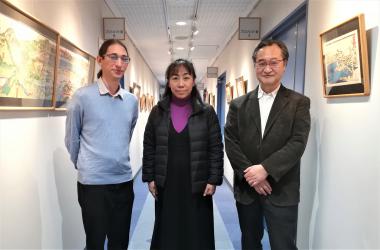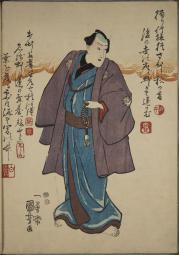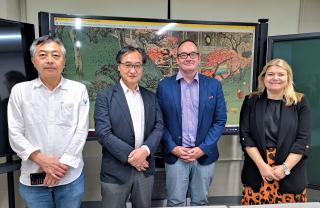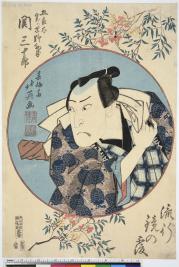-
[イベント情報]December 11, 2023(Mon)
The 13th Forum for Knowledge, Arts, and Culture in Digital Humanities will be held online on Saturday, March 23, 2024. We are now calling for presenters to join this event.
■ Date: March 23 (Sat), 2024
■ Participation method: To be confirmed
Venue: Ritsumeikan University Osaka Umeda Campus
Osaka Fukoku Seimei Building, 2-4 Komatsubarachō, Kita Ward, Osaka, 530-0018*The time will be adjusted depending on the number of presenters.
*Depending on the situation of the spread of COVID-19, the event may be held in a hybrid format or entirely online via ZOOM.
■ Registration:
Please register via the URL below:
https://forms.gle/J5JAzzRFuv1mbPHo8
Registration deadline: February 5 (Mon), 2024.
■ Presentation time: 20 minutes including Q&A (to be adjusted according to the number of presenters).
(Presentation time and instructions for submitting presentation materials will be sent to the presenters after the deadline.)
Participation is free of charge.
■ Research fields:
1. Research in the arts and culture and other fields using information technology
2. Research in information technology that can be applied to arts, culture, and other fields■ Samples of research presentation content:
1. Structural analysis, modeling, visualization, and knowledge discovery of information and knowledge in the arts and other fields
2. Representation, production, organization, database construction, search and provision of information and knowledge in the arts and other fields
3. E-publishing, digital libraries, digital museums and art galleries
4. Terminology in the arts and other fields, thesaurus
5. Information and knowledge distribution and intellectual property rights in the arts and other fields
6. Open data, data publishing, linked data
7. The internet, semantic web, web x.0, etc.
8. Other research and developments related to information and knowledge for culture at large
Organizer: The Forum for Knowledge, Arts, and Culture in Digital Humanities
Facilitators: Ryo Akama (Ritsumeikan University), Mamiko Sakata (Doshisha University), Naoki Takubo (Kindai University), Takehiko Murakawa (Wakayama University)
Co-organizers: The Kansai Division of the Art Documentation Society and the Kansai Division of the Japan Society of Information and Knowledge
In cooperation with: International Joint Digital Archiving Center for Japanese Art and Culture (ARC-iJAC), Art Research Center, Ritsumeikan University.
Inquiries: kacimeeting+2024■gmail.com (please change "■" to "@")
About the Forum for Knowledge, Arts, and Culture in Digital Humanities
Along with the rapid development of the digital and information environment in recent years, we are seeing more and more cross-disciplinary research in academic fields with an awareness of "information" and "digital". This trend is gaining momentum in higher education and research activities as well, and educational programs and course activities related to this trend are being enhanced.
The need for opportunities for academic exchange among undergraduate and graduate students and young researchers studying in such programs under new research themes in line with the times is ever increasing.
For this reason, the Forum for Knowledge, Arts, and Culture in Digital Humanities was established in 2011 as a place for presentation and exchange, with a focus on graduate students and young researchers interested in information and knowledge research in arts, culture, and other related fields in mind. 11 research meetings have been held to date.
This meeting is positioned as a place where participants can mutually discover new research themes and methods through human exchange in different fields, and we also welcome exploratory and adventurous presentations that are slightly different from conventional conference presentations.
■ Related links:
[イベント情報]December 1, 2023(Fri)
On December 1, 2023, Kazuko Kameda-Madar, Visiting Professor of the Hebrew University of Jerusalem, Israel (HUJI), was at the Art Research Center (ARC) and discussed about collaboration in digital humanities research with Prof. Ryo Akama (College of Letters/Director of the ARC) and Dr. Travis Seifman (Kinugasa Research Organization/Research Manager of the ARC).
[イベント情報]November 29, 2023(Wed)The 126th International ARC Seminar will be held as a webinar on Wednesday, November 29, from 18:00 JST.
The program is as follows:
Speaker: Timon Screech (Professor, Research Division, International Research Center for Japanese Studies (Nichibunken))
Topic: New Light on Nikkō: Thoughts on the Dutch Lanterns at the Shrine-Mausoleum of Tokugawa Ieyasu
Date: Wednesday, November 29, 18:00 - 19:30 JST
Participation: online via Zoom, free of charge (no reservation required)
[イベント情報]November 27, 2023(Mon)The International Joint Digital Archiving Center for Japanese Art and Culture (ARC-iJAC),
Art Research Center, Ritsumeikan University, presents:Training Course to Decipher Japanese Cursive Script (Kuzushiji) with the ARC Transcription Support and Archiving System
<Tutor guidance provided>
We are pleased to announce that the Training Course for the ARC Transcription Support and Archiving System for Japanese Cursive Script (kuzushiji) with tutor guidance will be held in FY2023.
This training course will be conducted online using the ARC databases of early Japanese books, ukiyo-e, and old documents, as well as the ARC Kuzushiji Transcription Support and Archiving System, allowing participants to practice reading kuzushiji anytime, anywhere, and at their own pace. Features include an AI-enabled function to read kuzushiji and online guidance provided by experienced tutors.
Unlike one-off kuzushiji courses, you can improve your transcription skills while you read through the books and materials independently.
We welcome applications from beginners and intermediate-level participants and those who wish to support a project to transcribe a specific work or group of works.
Participation is free of charge.
This training course is supported by the Consortium for Global Japanese Studies FY2023.
If you would like to participate, please apply using the form below.
↓↓↓
Deadline: December 11 (Mon), 2023, 12:00 JST
[Details of the Training Course]
Period: December 20, 2023, to March 15, 2024
Language of Instruction: Japanese
Target:
1. Beginners to intermediate level users who wish to transcribe documents written in kuzushiji (capacity: 25 people).
2. Individuals and groups who would like to advance their own projects using the ARC Kuzushiji Transcription Support and Archiving System (individual correction is not provided, but consultation for difficult-to-read characters is available (capacity: 5 people).
[Schedule]
Dec 15: Notice of acceptance (tentative)
Dec 20: Overview of the training course and introduction to the system at 9:00 and 20:00 JST (online/video on demand available)
Jan, Feb: Mini training sessions shall be held as needed
Late March: Closing meeting
Inquiries:
Office of the International Joint Digital Archiving Center for Japanese Art and Culture (ARC-iJAC)
Art Research Center (ARC), Ritsumeikan University
E-mail: r-darc@st.ritsumei.ac.jp
Tel.: +81 75-465-8476 (ext. 2832)
[イベント情報]November 20, 2023(Mon)On November 20, 2023, Prof. Makoto Goto and Prof. Masakatsu Nagai of the National Institutes for the Humanities (NIHU) visited the Art Research Center (ARC).
Besides a tour of the ARC building and facilities, discussions and an exchange of opinions on collaboration in digital humanities research took place with Prof. Ryo Akama (College of Letters/Director of the ARC) and Prof. Keiji Yano (College of Letters/Deputy Director of the ARC).
[イベント情報]November 16, 2023(Thu) Supported by the International Joint Digital Archiving Center for Japanese Art and Culture (ARC-iJAC) "International Joint Research with Research Fund B. International Open Theme" of the Art Research Center, Ritsumeikan University, a research team at the Complutense University of Madrid (UCM), Spain, led by Dr. Pilar Cabañas, has since FY 2022 been conducting an international joint research project to digitally archive ukiyo-e held by the Complutense University.
Supported by the International Joint Digital Archiving Center for Japanese Art and Culture (ARC-iJAC) "International Joint Research with Research Fund B. International Open Theme" of the Art Research Center, Ritsumeikan University, a research team at the Complutense University of Madrid (UCM), Spain, led by Dr. Pilar Cabañas, has since FY 2022 been conducting an international joint research project to digitally archive ukiyo-e held by the Complutense University.As one of the project outcomes, we are pleased to announce that a digital exhibition on shini-e (memorial prints), In memoriam. Japanese shinie prints, has opened. It can be viewed at the following link:
https://patrimoniodigital.ucm.es/s/shinie-en/page/welcome
The purpose of this exhibition is to explain the meaning and offer a socio-cultural contextualization to the shini-e genre, which became popular in the mid-19th century, based on the shini-e in the UCM Collection.
The complete ukiyo-e collection of the UCM is available in the →ARC Ukiyo-e Portal Database.
Access to the UCM collection for researchers in both Japan and abroad, including metadata and analysis of the artworks, is facilitated through the established link between both institutions.
[イベント情報]November 8, 2023(Wed)The 125th International ARC Seminar will be held as a webinar on Wednesday, November 8, from 18:00 JST.
The program is as follows:
Speaker: Ellis Tinios (Honorary Lecturer, University of Leeds, United Kingdom and ARC Visiting Researcher)
Topic: Hokusai the Alchemist: an exploration of sources for his book illustrations (held in English)
Date: Wednesday, November 8, 18:00 - 19:30 JST
Participation: online via Zoom, free of charge (no reservation required)
*This webinar is open to everyone, and non-ARC members are also invited to participate via YouTube.
[イベント情報]November 7, 2023(Tue)On November 7, 2023, Prof. Chih-Ming Chen (Director, Research Center for Chinese Cultural Metaverse in Taiwan, National Chengchi University) and Prof. Shi-Chi Mike Lan (Deputy Director, Research Center for Chinese Cultural Metaverse in Taiwan, National Chengchi University) visited the Art Research Center (ARC).
Besides a tour of the ARC building and facilities, discussions and an exchange of opinions on collaboration in digital humanities research and education took place with Prof. Ryo Akama (College of Letters/Director of the ARC) and Prof. Keiji Yano (College of Letters/Deputy Director of the ARC).
[イベント情報]November 6, 2023(Mon)
On November 6, 2023, Prof. Graeme Earl (Head of the College of Humanities, SOAS University of London) visited the Art Research Center (ARC).
Besides a tour of the ARC building and facilities, discussions and an exchange of opinions on collaboration in digital humanities research and education took place with Prof. Ryo Akama (College of Letters/Director of the ARC) and Prof. Keiji Yano (College of Letters/Deputy Director of the ARC).
[イベント情報]November 3, 2023(Fri)Ako City Chushingura Digital Exhibition Room:
https://www.arc.ritsumei.ac.jp/lib/vm/akochushingura/The Art Research Center (ARC), Ritsumeikan University, is pleased to announce that the 3rd digital exhibition in the Ako City Chushingura Digital Exhibition Room, Chushingura Ukiyo-e from Kamigata, is available.
Based on the special exhibition Chushingura Ukiyo-e from Kamigata held at the Ako City Museum of History in 2022, this digital exhibition includes works in the Ako City Chushingura Ukiyo-e Database, along with works in the collection of the ARC.
Single-page ukiyo-e prints began to be published in the Kamigata region of Osaka and Kyoto in the Kansei period (1789-1800). Over a period of 70 years from then until the end of the Edo period, plays related to Chushingura were staged more than 200 times. In conjunction with these productions, large numbers of actor prints were created.
Kamigata-e has distinctive characteristics that differ from Edo-e, and the unique world of these artworks is highly appreciated in Europe and the United States. Our exhibition showcases some aspects of the development of Chushingura culture in the Kamigata region, mainly depicted in yakusha-e, shibai-e, and omocha-e.
We also recommend you view this exhibition together with the first digital exhibition, Aspects of Images of the Raid, held in 2019, and the second exhibition, Head of the Loyal Warriors: Oboshi Yuranosuke, held in the following year.















